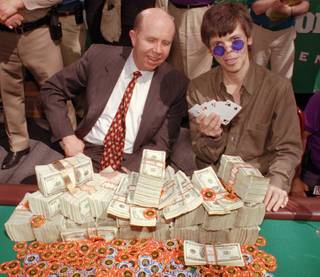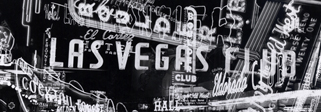Thursday, May 15, 2008 | 3 a.m.
Throughout the final day’s play at the 1997 World Series of Poker, Stu Ungar periodically reached into his shirt pocket and pulled out a photo of his daughter, Stefanie.
Through his familiar blue-lensed granny glasses, he stared at the teen’s portrait and smiled before tucking it back into his shirt pocket — close to his heart — and playing his hand.
Ungar, a hard-luck gambler, had not won poker’s premier event – the $10,000 buy-in-no-limit Texas Hold’ em world title – in 16 years. In those bygone days he was knows as Stu “The Kid” because of his thin build and boyish features.
Yet, here he was — his youthful look replaced by gauntness from years of substance abuse and illnesses and his once black hair greying — on the verge of capturing his third such title at Binion’s Horsehoe and collecting $1 million.
Stefanie admired her father in good times and bad. She would have loved him, win or lose.
“If I needed something, he’d give me his last $200 without me knowing it was all he had,” she told the Sun in a 1998 interview. “Then he would walk around broke for days."
Before the 1997 World Series of Poker, Ungar — who had made and lost millions of dollars in his storied gambling career — was broke. A friend paid his way into the main event, where he made history, besting a then record field of 312.
Upon winning the 1997 championship to go along with titles he won in 1980 and 1981, Stu “The Comeback Kid” Ungar exclaimed, "I just played so perfect — so perfect."
But fame is fleeting – and so is the money.
After paying off gambling debts and suffering heavy losses on horse and sports wagers, Ungar was broke two months after winning the big event.
Ungar then got ill and was unable to defend his title at the 1998 World Series.
He did not live to see the dawning of the 21st century nor the great international poker playing boom that came with it.
Ungar was found dead in a bed in a Las Vegas Strip motel room in November 1998 at age 45. Despite having small amounts of cocaine and other drugs in his system, the official cause of death was coronary atherosclerosis.
Ungar had only eight hundred dollars in his pocket. Gamblers footed the bill for his funeral and burial.
Still, Ungar’s classic comeback in 1997 remains one of the most endearing and enduring moments in the history of the World Series of Poker, the granddaddy of all gaming tournaments.
Indeed, Ungar’s career reflects the growth in the popularity of poker and the World Series.
When Ungar won his first event in 1980, there were just 73 players in the field and he won a then-record $385,000.
Those were the days before satellite tourneys that give players a chance to win large entry fees at a fraction of the cost, and long before Internet poker.
Players who entered the main event back then either had to put up their own money or get a rich friend to do it for them and then share any prize money the player won.
In those days, Ungar was a brash and cocky world-class gin rummy player who learned how to play poker shortly after coming to Las Vegas from the Lower East Side of New York in 1978. He got real good, real fast.
But that’s not unlike today’s new generation of poker stars.
Chris Moneymaker, who won the no-limit hold ‘em world title in 2003, and Greg Raymer, the 2004 main event champ, both qualified through on-line satellite tournaments.
Moneymaker won a then-record $2.5 million from a then-record filed of 838 other players. Raymer’s first place prize doubled that at $5 million and he competed in a field of 2,576.
In 2006, Jamie Gold won the title and $12 million from the current record field of 8,773 – more than 28 times the field Ungar faced in 1997 and more than 120 times the field Ungar had to overcome in 1980.
By comparison, in 18 years of competing at the World Series, Ungar won a total $2,081,478 in the main event and preliminary events combined.
The current champion, Jerry Yang, like Ungar, had only been playing poker for two years. He got into the World Series main event by winning a $225 satellite event at an out-of-state casino. He parlayed that into $8.25 million and bested a field of 6,357 other players.
Given the huge fields today, it is doubtful that anyone will be able to overcome the odds and equal the record feat of three main event wins currently shared by Ungar and Poker Hall of Famer Johnny “The Grand Old Man” Moss, who died in 1995.
Moss won his titles by being voted champion by his peers in 1970, besting seven others in a winner-take-all, single-table tourney in 1971 and topping 15 others in 1974 to win a then-record $160,000 first prize.
Two other players have won the main event twice: Doyle “Texas Dolly” Brunson in 1976 and 1977 and Johnny Chan in 1987 and 1988.
The history of the World Series of Poker is one of steady growth in participants and prize money followed by booming growth at the 2004 event.
Three factors played a role in the unprecedented growth spurt of recent years: The popularity of Internet poker play, the onset of large “super” satellite events, and television.
In recent times, it has been practically impossible to turn on cable TV at nights or on weekends and not find a televised poker game while channel surfing.
However, the government’s crackdown on Internet gaming may have slowed the World Series poker boom. Some 2,400 fewer players signed up for the 2007 main event than for the record 2006 no-limit hold ‘em tilt.
Only one other time in the tournament’s 38-year history did that happen – 1992, when 201 players came up with the buy-in, 14 less than in 1991, the first year in which the top prize was $1 million.
Each year, the World Series features about a month of preliminary world championships in different games — 7-card stud, 7-card hi-lo, Omaha hold ‘em, etc. – at various buy-in amounts.
Each tournament since the first has culminated with the $10,000 buy-in, no-limit Texas ‘hold em championship – the overall world championship of poker.
The World Series always has been held in Las Vegas – first at Binion’s Horseshoe and in recent years at the Rio.
In addition to the prize money that is generated from the buy-ins, the winners are awarded gold bracelets.
The World Series can trace its roots to1951 and a marathon heads-up poker game played several hours daily from January to May at Binion’s Horseshoe between Moss and the legendary Nick “The Greek” Dandolos.
The future Poker Hall of Fame members played every known version of poker, but not Texas hold ‘em because that game was not introduced to Las Vegas until 1963 by fellow Poker Hall of Famer Felton “Corky” McCorquadale.
Dandolos lost an estimated $2 million to $4 million in the marathon game.
Binion’s founder Benny Binion promoted the game that drew large crowds. There he saw potential for a future tournament format that would attract sizeable crowds of onlookers — and potential gamblers — into his casino.
In 1970, Binion’s Horseshoe held the first World Series, which was more of a poker players convention. The champions of various types of poker that year were determined by a vote of the players.
The next year, the freeze-out style, where all players started with equal amounts of chips and were eliminated until just one player had all of the chips, was implemented for tournament events and is still used today.
Over the years, games have been added based on their popularity while others have been eliminated when their popularity waned.
Most of the games played in tournaments today are varieties of Texas, Hold ‘em, Omaha or 7-card stud.
The casino makes its money and pays its huge numbers of dealers by taking a small percentage of the buy-ins. The bulk of the fees generates all of the prize money.
In 1994, for the 25th anniversary — the silver anniversary — the Horseshoe added as part of the main event winner’s purse his weight in silver bars. Russ Hamilton, a 300-pound-plus player, won the event.
In 2004, Harrah’s Entertainment purchased Binion’s Horseshoe and, in doing so, obtained the rights to the World Series of Poker.
The tournament was moved to Rio just off the Strip. In 2005, the last two days of the no-limit hold ‘em championship were held at the Horseshoe as part of Las Vegas’ centennial celebration.
Also in 2005, a World Series tournament circuit was started at Harrah’s casinos throughout the United States, culminating with a tournament of champions and a $1 million first prize at Caesars Palace.
Since 1973, the World Series of Poker main event most years has been videotaped and edited for play at a later date. Those broadcasts, especially the early ones, were used to draw interest to the following year’s tournament.
Videotaped footage of the 1988 World Series main event was used in the movie “Rounders.”
The 1998 film featured Matt Damon as a young, skilled poker player torn between finishing college and getting his law degree or quitting school, going to Las Vegas and playing in the World Series of Poker.
In an example of life imitating art, Damon entered the 1998 World Series and did pretty well against some of the world’s top players, scooping a few pots.
Then, in a classic showdown, Damon, holding two kings, went all-in against Poker Hall of Famer Doyle Brunson. Unfortunately for the Oscar winner, the veteran gambler had two aces that held up, knocking Damon out of the event.
For several years in the 1990s, the Horsehose also hosted a winter tournament, The Hall of Fame Classic, to complement its springtime event and induct new members into the Poker Hall of Fame at the Horseshoe.
That event, however, attracted fewer players and produced smaller prize purses than the World Series and was dropped in 1998, despite at the time being the second richest poker tourney on the circuit.
There also was talk that year that the Horseshoe would drop the World Series of Poker after Becky Behnen, Benny Binion’s daughter, took over control of the Horseshoe from her brother, Jack Binion.
Jack Binion had continued to host the World Series of Poker in Las Vegas after his father died on Christmas Day 1989. It also was speculated in the late 1990s that the World Series would move to Jack Binion’s casino resorts in Mississippi.
But Behnen vowed to keep the World Series going at the Horseshoe and did so until the property was sold.
Past Winners
| Year | Winner | Prize | Entrants |
| 1970 | Johnny Moss | Voted by peers | None |
| 1971 | Johnny Moss | $30,000 | 6 |
| 1972 | "Amarillo Slim" Preston | $80,000 | 8 |
| 1973 | "Puggy" Pearson | $130,000 | 13 |
| 1974 | Johnny Moss | $160,000 | 16 |
| 1975 | "Sailor" Roberts | $210,000 | 21 |
| 1976 | Doyle Brunson | $220,000 | 22 |
| 1977 | Doyle Brunson | $340,000 | 34 |
| 1978 | Bobby Baldwin | $210,000 | 42 |
| 1979 | Hal Fowler | $270,000 | 54 |
| 1980 | Stu Ungar | $385,000 | 73 |
| 1981 | Stu Ungar | $375,000 | 75 |
| 1982 | Jack Straus | $520,000 | 104 |
| 1983 | Tom McEvoy | $540,000 | 108 |
| 1984 | Jack Keller | $660,000 | 132 |
| 1985 | Bill Smith | $700,000 | 140 |
| 1986 | Berry Johnston | $570,000 | 141 |
| 1987 | Johnny Chan | $625,000 | 152 |
| 1988 | Johnny Chan | $700,000 | 167 |
| 1989 | Phil Hellmuth Jr | $755,000 | 178 |
| 1990 | Mansour Matloubi | $895,000 | 194 |
| 1991 | Brad Daugherty | $1,000,000 | 215 |
| 1992 | Hamid Dastmalchi | $1,000,000 | 201 |
| 1993 | Jim Bechtel | $1,000,000 | 220 |
| 1994 | Russ Hamilton | $1,000,000 | 268 |
| 1995 | Dan Harrington | $1,000,000 | 273 |
| 1996 | Huck Seed | $1,000,000 | 295 |
| 1997 | Stu Ungar | $1,000,000 | 312 |
| 1998 | Scotty Nguyen | $1,000,000 | 350 |
| 1999 | Noel Furlong | $1,000,000 | 393 |
| 2000 | Chris Ferguson | $1,500,000 | 512 |
| 2001 | Juan Carlos Mortensen | $1,500,000 | 613 |
| 2002 | Robert Varkonyi | $2,000,000 | 631 |
| 2003 | Chris Moneymaker | $2,500,000 | 839 |
| 2004 | Greg Raymer | $5,000,000 | 2,576 |
| 2005 | Joe Hachem | $7,500,000 | 5,619 |
| 2006 | Jamie Gold | $12,000,000 | 8,773 |
| 2007 | Jerry Yang | $8,250,000 | 6,358 |
| 2008 | Peter Eastgate | $9,152,416 | 6,844 |


 Explore Las Vegas’ past and present
Explore Las Vegas’ past and present Boomtown: The Story Behind Sin City
Boomtown: The Story Behind Sin City Neon Boneyard: A 360° look
Neon Boneyard: A 360° look Mob Ties: See the connections
Mob Ties: See the connections Implosions: Classic casinos crumble
Implosions: Classic casinos crumble